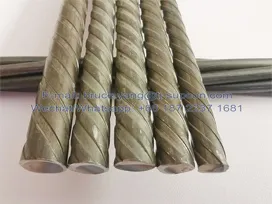Repair of prestressed steel corrosion
In the repair of prestressed steel corrosion, the hydrogen effect is a common problem that needs to be considered. It will affect the effectiveness and safety of the repair method. The common repair methods introduced below are all affected by the hydrogen effect when applied to prestressed steel repair. The durability repair technologies of concrete structures mainly include electrochemical repair and physical repair technologies. Physical repair technology is to remove rust and prevent rust on steel bars with mild corrosion in concrete. When large rust expansion cracks appear, the deteriorated concrete protective layer is chiseled off and the steel bars are reinforced or replaced. Electrochemical repair technologies mainly include sacrificial anode cathodic protection method, impressed current assisted anode method, electrochemical dechlorination technology, electrochemical re-alkalization, electromigration rust inhibitor technology, bidirectional electromigration technology, etc. At present, many technologies are used to repair steel corrosion, but the application scope of these technologies is not wide enough and the engineering effect needs to be optimized. The repair methods of PC WIRE corrosion are based on the repair of ordinary steel corrosion. Some repair methods lack certain practicality in the repair of prestressed steel corrosion. The following are common repair methods. (1) Cathodic protection method of sacrificial anode: This method usually connects a metal with a more negative potential to the steel bars inside the concrete. When the reaction occurs, the anode material protects the steel bars by self-consumption and dissolution. Zinc is usually used as the anode. Since the potential of zinc is lower than that of the steel bars, the anodic reaction occurs first.
When the potential difference between the sacrificial anode and the protected cathode is large, hydrogen evolution reaction will occur on the surface. Similarly, when the current of the auxiliary anode method of impressed current is too large, hydrogen evolution reaction will also occur at the cathode. The more prominent problem for prestressed steel bars is hydrogen embrittlement failure, which is a brittle failure. Therefore, the cathodic protection method of sacrificial anode and the auxiliary anode method of impressed current cannot be used for prestressed steel bar corrosion repair under normal circumstances. If these two methods are needed, the hydrogen embrittlement sensitivity of the steel bar material, the current flowing in the prestressed steel bar, and the repair efficiency affected by the current size need to be solved.

(2) Electrochemical dechlorination: Electrochemical dechlorination is an effective method to remove chloride ions from reinforced concrete. The steel bar is used as the cathode and the external metal sheet is used as the anode. The chloride ions are removed by applying voltage to restore the passivation of the PC steel bar. The dechlorination system is very similar to the cathodic protection system with an external power supply. The difference is that this system often uses a temporary anode and the applied current density is higher than that of the cathodic protection system. This method is simple to operate and has low cost. However, there are some challenges when electrochemical dechlorination is applied to prestressed steel repair: the generation of hydroxide ions on the surface of the steel bar, the accumulation of alkali metal cations around the steel bar, the significant increase in alkalinity may induce the occurrence of alkali aggregates, the change in the performance of the steel bar and concrete after dechlorination, and the hydrogen evolution reaction on the surface of the steel bar.
3) Electrochemical re-alkalization: Direct current is passed between the external electrode on the concrete component and the steel bar, with the external electrode as the anode and the steel bar as the cathode, and the steel bar is cathodically polarized. The generation of hydroxide ions on the surface of the steel bar increases the alkalinity around the concrete, thereby providing the necessary conditions for the passive film on the surface of the steel bar and re-alkalization.
(4) Electrodeposition repair method: A small current is applied to the concrete. Under the action of the electric field, cations migrate to the concrete surface, and the generated precipitates block the microcracks. This method can be used to repair concrete microcracks in underwater environments, and has a good effect on the repair of reinforced concrete corroded by chloride salts. In the application of this repair method, the selection of electrodeposition solution is crucial.
(5) Bidirectional electroosmosis method: A stainless steel mesh is arranged on the outer surface of the concrete, with the steel bar as the cathode and the metal mesh as the anode. Under the action of the electric field, the cations electrolyzed by the rust inhibitor migrate to the surface of the steel bar, and the chloride ions can also be eliminated, thereby achieving the purpose of protecting the steel bar
The above lists five common technologies for repairing steel bar corrosion.

